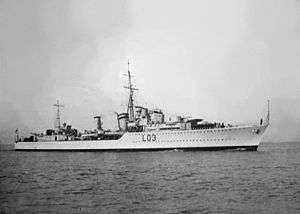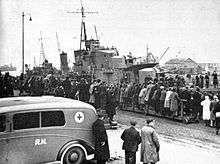HMS Cossack (F03)
HMS Cossack was a Tribal-class destroyer named after the Cossack people of the Russian and Ukrainian steppe. She became famous for the boarding of the German supply ship Altmark in Norwegian waters, and the associated rescue of sailors originally captured by the Admiral Graf Spee. She was torpedoed by U-563 on 23 October 1941, and sank 4 days later, on 27 October.
 HMS Cossack under way in 1938 | |
| History | |
|---|---|
| Name: | Cossack |
| Namesake: | Cossack |
| Ordered: | 10 March 1936 |
| Builder: | Vickers-Armstrongs |
| Cost: | £341,082 |
| Laid down: | 9 June 1936 |
| Launched: | 8 June 1937[1] |
| Completed: | 10 June 1938 |
| Identification: | Pennant number: L03, F03 & G03 successively |
| Fate: | Sunk, 27 October 1941 |
| General characteristics (as built) | |
| Class and type: | Tribal-class destroyer |
| Displacement: |
|
| Length: | 377 ft (115 m) (o/a) |
| Beam: | 36 ft 6 in (11.13 m) |
| Draught: | 11 ft 3 in (3.43 m) |
| Installed power: |
|
| Propulsion: | 2 × shafts; 2 × geared steam turbines |
| Speed: | 36 knots (67 km/h; 41 mph) |
| Range: | 5,700 nmi (10,600 km; 6,600 mi) at 15 knots (28 km/h; 17 mph) |
| Complement: | 190 |
| Sensors and processing systems: | ASDIC |
| Armament: |
|
Description
The Tribals were intended to counter the large destroyers being built abroad and to lend gun support to the existing destroyer flotillas and were thus significantly larger and more heavily armed than the preceding I class.[2] The ships displaced 1,891 long tons (1,921 t) at standard load and 2,519 long tons (2,559 t) at deep load.[3] They had an overall length of 377 feet (114.9 m), a beam of 36 feet 6 inches (11.1 m)[4] and a draught of 11 feet 3 inches (3.4 m).[5] The destroyers were powered by two Parsons geared steam turbines, each driving one propeller shaft, using steam provided by three Admiralty three-drum boilers. The turbines developed a total of 44,000 shaft horsepower (33,000 kW) and gave a maximum speed of 36 knots (67 km/h; 41 mph).[4] The ships carried enough fuel oil to give them a range of 5,700 nautical miles (10,600 km; 6,600 mi) at 15 knots (28 km/h; 17 mph).[5] The ships' complement consisted of 190 officers and ratings, although the flotilla leaders carried an extra 20 officers and men for the Captain (D) and his staff.[6]
The primary armament of the Tribal-class destroyers was eight quick-firing (QF) 4.7-inch (120 mm) Mark XII guns in four twin-gun mounts, designated 'A', 'B', 'X', and 'Y' from front to rear. For anti-aircraft (AA) defence, they carried a single quadruple mount for the 40-millimetre (1.6 in) QF two-pounder Mk II "pom-pom" AA gun and two quadruple mounts for the 0.5-inch (12.7 mm) Mark III machine gun.[7] The ships were fitted with a single above-water quadruple mount for 21-inch (533 mm) torpedoes.[6] The Tribals were not intended as anti-submarine ships, but they were provided with ASDIC, one depth charge rack and two throwers for self-defence, although the throwers were not mounted in all ships;[8] Twenty depth charges were the peacetime allotment, but this increased to 30 during wartime.[9]
Wartime modifications
Heavy losses to German air attack during the Norwegian Campaign demonstrated the ineffectiveness of the Tribals' anti-aircraft suite and the RN decided in May 1940 to replace 'X' mount with two QF 4-inch (102 mm) Mark XVI dual-purpose guns in a twin-gun mount. To better control the guns, the existing rangefinder/director was modified to accept a Type 285 gunnery radar as they became available. The number of depth charges was increased to 46 early in the war, and still more were added later.[10] To increase the firing arcs of the AA guns, the rear funnel was shortened and the mainmast was reduced to a short pole mast.[11]
Construction and career
She was laid down at the Walker Naval Yard of Vickers-Armstrongs in Newcastle upon Tyne on 9 June 1936, launched on 8 June 1937 by Mrs. S. V. Goodall, commissioned on 7 June 1938 and completed on 14 June 1938. During her trials Cossack made 36.223 knots (67.085 km/h; 41.685 mph) at 366.4 RPM with 44,430 shp (33,130 kW) at 2,030 long tons (2,060 t).[12]
Altmark incident

Cossack's first action was on 16 February 1940, under the command of Philip Vian. This was the Altmark Incident in Jøssingfjord, Norway which resulted in the freeing of the Admiral Graf Spee's prisoners who were being held aboard the supply ship Altmark and the death of eight crew members of the German ship.
In the incident the German tanker rammed her with the stern at an angle of about 30° at the level of her bridge and drove the destroyer towards the fiord wall. The Norwegian officers present later reported that only the mass of ice piled up prevented the destroyer being crushed onto the rocky shore. The powerful engines of the destroyer made her escape from the squeeze possible.[13] Cossack arrived at Leith on 17 February with the 299 freed prisoners.[14] She had to be docked for her propellor and A-brackets to be checked in case they had been damaged by the thick ice in the fiord. They were unharmed, but her stern plating had to be repaired where it had been bumping against Altmark.[15]
The Norwegian Government subsequently protested at Cossack's breach of Norway's neutrality and demanded the return of the prisoners, with the German government further protesting at the act of violence committed against Altmark.[16]
Second Battle of Narvik
Cossack participated in the Second Battle of Narvik in April 1940. Later that year, she was part of the force which was assigned to hunt for a German surface raider that had been reported breaking out into the North Atlantic. The force consisted of the battlecruiser Hood, the light cruiser Edinburgh, and the destroyers Electra, Echo, Escapade, and Cossack. The report turned out to be false, so after spending a week at sea, including Christmas Day, she returned to port on New Year's Eve.
Chasing Bismarck
In May 1941, she participated in the pursuit and destruction of the German battleship Bismarck. While escorting Convoy WS-8B to the Middle East, Cossack and four other destroyers broke off on 26 May, and headed towards the area where Bismarck had been reported. They found Bismarck that evening and made several torpedo attacks in the evening and into the next morning. No hits were scored, but they kept the Bismarck's gunners from getting any sleep, making it easier for the battleships to attack the Bismarck the next morning. During the battle one of Bismarck’s shells sheared off Cossack’s antenna.
Loss
On 23 October 1941, Cossack was escorting a convoy from Gibraltar to the United Kingdom when she was struck by a single torpedo fired by the German submarine U-563 commanded by Klaus Bargsten. She was taken in tow by a tug from Gibraltar on 25 October, but the weather worsened and the tow was slipped on 26 October. Cossack sank in the Atlantic west of Gibraltar on 27 October 1941. 159 of her crew were lost.
Notes
- The Times (London), Wednesday, 9 June 1937, p.13
- Lenton, p. 164
- English, p. 14
- Lenton, p. 165
- English, p. 12
- Whitley, p. 99
- Hodges, pp. 13–25
- Hodges, pp. 30–31, 40
- English, p. 15
- Friedman, p. 34; Hodges, pp. 41–42
- Whitley, p. 116
- March, p. 362
- Lochner p. 64.
- The Times (London), Monday, 19 February 1940, p.10
- The Altmark Incident on the home page of the HMS Cossack Association
- The Times (London), Monday, 19 February 1940, p.8
References
- Brice, Martin H. (1971). The Tribals. London: Ian Allan. ISBN 0-7110-0245-2.
- English, John (2001). Afridi to Nizam: British Fleet Destroyers 1937–43. Gravesend, Kent: World Ship Society. ISBN 0-905617-64-9.
- Friedman, Norman (2006). British Destroyers and Frigates, the Second World War and After. Annapolis, Maryland: Naval Institute Press. ISBN 1-86176-137-6.
- Haarr, Geirr H. (2010). The Battle for Norway: April–June 1940. Annapolis, Maryland: Naval Institute Press. ISBN 978-1-59114-051-1.
- Haarr, Geirr H. (2009). The German Invasion of Norway, April 1940. Annapolis, Maryland: Naval Institute Press. ISBN 978-1-59114-310-9.
- Hodges, Peter (1971). Tribal Class Destroyers. London: Almark. ISBN 0-85524-047-4.
- Lenton, H. T. (1998). British & Empire Warships of the Second World War. Annapolis, Maryland: Naval Institute Press. ISBN 1-55750-048-7.
- March, Edgar J. (1966). British Destroyers: A History of Development, 1892–1953; Drawn by Admiralty Permission From Official Records & Returns, Ships' Covers & Building Plans. London: Seeley Service. OCLC 164893555.
- Rohwer, Jürgen (2005). Chronology of the War at Sea 1939–1945: The Naval History of World War Two (Third Revised ed.). Annapolis, Maryland: Naval Institute Press. ISBN 1-59114-119-2.
- Whitley, M. J. (1988). Destroyers of World War Two: An International Encyclopedia. Annapolis, Maryland: Naval Institute Press. ISBN 0-87021-326-1.
- R. K. Lochner: Als das Eis brach: Der Krieg zur See um Norwegen 1940. Heyne Verlag, München 1983.
External links
| Wikimedia Commons has media related to HMS Cossack (F03). |